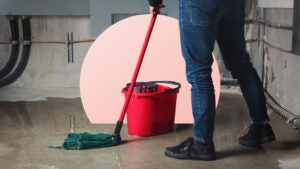Extreme weather: Using cash value to cover home repairs

The back-to-back devastation of Hurricanes Helene and Milton left homeowners grappling with overwhelming repair costs. Helene alone tore through Florida, the Carolinas and parts of the Southeast, causing up to $47.5 billion in total damage. Yet here’s the harsh reality: an estimated 80 percent of Florida property owners were uninsured against flood damage — meaning countless families now face staggering out-of-pocket costs to rebuild. And Florida isn’t alone; the lack of flood insurance is likely to be similar in the other impacted states.
These figures highlight a significant gap in traditional homeowners insurance, which often excludes flood coverage and other severe weather impacts. For those with a permanent life insurance policy that builds cash value, tapping into that resource could be a much-needed financial cushion.
Bankrate’s expertise in navigating complex financial and insurance topics can help you understand how using the cash value in life insurance might bridge the gap where homeowners insurance falls short, providing essential support for repairs and recovery.
Does homeowners insurance cover storm damage?
Homeowners insurance is often the first line of defense when it comes to protecting property from natural disasters, but it has critical limits, especially with storm-related damage. While most standard policies cover wind damage from hurricanes, they frequently exclude flood damage — a devastating reality for many homeowners after Hurricanes Helene and Milton. With such exclusions, repair costs from storm damage can quickly become overwhelming for those without additional flood insurance.
Beyond understanding what your policy will and won’t pay for, homeowners must also know the specific coverage limits for different types of claims. Your policy might feature a substantial percentage-based wind deductible or impose a sublimit of $10,000 for eligible water damage claims. Although you have coverage for specified losses in both scenarios, you could still be responsible for significant out-of-pocket expenses amounting to thousands of dollars.
-Shannon Martin, Bankrate Analyst and Licensed Insurance Agent
This gap means that after severe storms, homeowners often find themselves in need of alternate sources of funding for repairs. Whether it’s repairing structural damage from wind or addressing water damage after a flood, many may need to look beyond insurance to cover the costs.
With climate events becoming more severe and frequent, homeowners should consider not only reviewing their insurance coverage regularly but also exploring alternative financial resources, such as cash value life insurance, to ensure they’re equipped to handle unexpected repair expenses.
Using life insurance to pay for home repair
When disaster strikes and homeowners need funds for repairs, life insurance can offer financial flexibility — but it depends heavily on the type of policy you own. The key difference lies between term and permanent life insurance. While term life insurance provides coverage for a set period, typically 10 to 30 years, permanent life insurance (like whole, universal or variable life) can last a lifetime and includes a cash value component. This cash value builds over time and can be accessed through loans, withdrawals or policy surrender, offering several ways to tap into funds if repair costs mount.
For those with permanent life insurance, there are three main options for accessing cash value to cover home repairs:
- Policy loans: These allow you to borrow from your policy’s cash value, usually at favorable interest rates, without needing approval or affecting your credit score. Policy loans don’t reduce the death benefit if repaid, but if unpaid, they reduce what beneficiaries receive.
- Withdrawals: You can directly withdraw your cash value, but be aware that this permanently lowers the policy’s death benefit. Note: This is not an option on whole life policies.
- Surrender: If you no longer need life insurance coverage, surrendering the policy provides you with the the cash surrender value (the accumulated cash value less surrender fees or loan balances). This option fully cancels your life insurance, so it’s only worth considering if coverage is no longer necessary.
Each of these options provides a unique way to leverage the value of permanent life insurance to fund repairs, while term life insurance, which has no cash value, requires a different approach. Here’s how term life insurance can still offer financial assistance.
Term life insurance as collateral
Though term life policies don’t have cash value, they can be useful for accessing funds through a process known as collateral assignment or collateralized loan. This approach allows policyholders to use their term policy as collateral to secure a loan, such as for home repairs. Here’s how it works:
- Finding a lender: Not all lenders accept term life insurance as collateral, so you’ll need to research and find a lender who allows collateral assignments for term policies. These assignments act as a form of guarantee, enabling you to use the death benefit as a security for the loan.
- Assigning beneficiaries: When using a term policy as collateral, the lender will be assigned as a beneficiary, giving them first claim to the policy’s death benefit in the event of your passing. Any remaining death benefit would then go to your designated family beneficiaries.
- Loan security: If you meet the loan obligations, the policy remains intact and the lender’s interest is removed once the loan is paid off. However, if the loan is unpaid, the lender receives their portion of the death benefit first, which can reduce the amount left for family members.
Collateral assignments can provide a way to leverage term life insurance for home repairs, but it’s important to carefully consider the policy’s terms, loan repayment obligations and potential impacts on your beneficiaries.
How cash value life insurance can provide funds for home repair
For homeowners facing costly repairs after severe weather, cash value life insurance can provide financial relief in ways term life insurance cannot. Permanent life insurance policies, such as whole and universal life, come with a built-in cash value that grows over time. This accumulated cash value offers policyholders several options to access funds — either through borrowing, withdrawing or even using the policy as collateral. However, it’s important to know that building substantial cash value within a life insurance policy takes years, and some permanent policies, such as guaranteed issue or guaranteed universal life insurance, will likely never build enough cash value worth accessing.
To access enough cash value for meaningful expenses, policyholders typically need to let their permanent life insurance grow for years. Purchasing a policy today won’t yield a quick loan tomorrow, so it’s crucial to think of cash value as a longer-term asset.
Here’s a breakdown of ways permanent life insurance cash value can be accessed to fund home repairs.
Borrowing against a life insurance policy
One of the most straightforward ways to leverage cash value is through a policy loan. A policy loan allows you to borrow from your own cash value without a formal loan approval process, making it quick and free from credit checks. Here’s how it can work for homeowners:
- Using cash value for repairs: With a policy loan, you’re borrowing against your life insurance’s accumulated cash value to access funds for pressing home repairs. Since you’re essentially borrowing from yourself, this doesn’t affect your credit report or involve repayment deadlines typical of traditional loans.
-
Payback options: Unlike traditional loans, there’s flexibility in how you choose to pay it back. You can either:
- Repay nothing: Some policyholders opt not to repay the loan. Instead, they let the outstanding loan balance reduce the death benefit, meaning beneficiaries receive less if the loan isn’t repaid before the policyholder’s death.
- Establish repayment: Others set up a payment plan to maintain the full death benefit. Repaying keeps the policy intact and allows you to borrow in the future if more funds are ever needed for repairs or other expenses.
Policy loans provide flexibility and immediate access to funds, but they also reduce the death benefit if left unpaid, impacting what beneficiaries receive. Large policy loans can also impact the long-term performance of a policy causing it to terminate with a phantom income tax gain.
Withdrawing from a life insurance policy
Another option for universal life (UL) policyholders is to withdraw directly from the cash value. Unlike a loan, a withdrawal permanently reduces the death benefit, meaning the amount removed is no longer accessible as part of the policy’s overall value. Here’s how withdrawals differ from loans:
- Cash at hand: A withdrawal gives you immediate cash for repairs without needing to pay it back. However, this is not available with all types of permanent life insurance; it’s typically unique to universal life policies.
- Death benefit impact: The primary consideration with a withdrawal is the permanent reduction to the death benefit. The amount withdrawn is simply subtracted on a dollar-for-dollar basis from the payout that beneficiaries would eventually receive, so it’s important to weigh this when considering a withdrawal.
Withdrawals can be appealing because they don’t require repayment, though they do reduce your family’s future financial support.
Using permanent life insurance as collateral
Cash value life insurance is also useful when it comes to collateral loans. Many lenders are willing to accept permanent life insurance as collateral because cash value offers a tangible backing to the loan. Here’s how this works:
- Reliable collateral: With term policies, lenders only receive payment if the borrower passes away. However, permanent life insurance offers built-up cash value that lenders can access if you default, making it a more secure option.
- Payment flexibility: As with any loan, you can negotiate repayment terms with the lender. And while the lender will require some security, you have flexibility in how you handle both the loan and the cash value’s future.
Using a permanent life policy as collateral can secure funds for repairs, offering an option that maintains your life insurance policy while using its value to your advantage. Each option — borrowing, withdrawing or using life insurance as collateral — offers ways to use your permanent life insurance for more than just a legacy tool.
Before pulling a large amount of money from your policy, it may be a good idea to request an inforce illustration from your insurance agent. Review it together to gauge how a loan or withdrawal may impact your policy long term so there are no unpleasant surprises down the road.
Alternative ways to pay for home repairs
When extreme weather strikes — whether it’s hurricanes, tornadoes or earthquakes — homeowners insurance may not cover all types of damage. Policy limitations often leave homeowners responsible for uninsured repairs, especially for flood damage, where separate flood insurance is typically required. Fortunately, if you need funds to repair your home after a natural disaster, there are several alternative financing options to consider:
- Unsecured personal loans: An unsecured personal loan can provide quick access to cash without requiring collateral. While interest rates tend to be higher than secured loans, these loans allow you to borrow based solely on your creditworthiness. For those with good credit, unsecured loans may be an accessible option to cover repairs that insurance won’t.
- Credit cards: Though best used for smaller, manageable expenses, credit cards can be a lifeline for immediate repairs. Some cards may offer introductory interest-free periods, allowing you to cover necessary repairs without accruing interest if paid off within the promotional period. However, carrying a balance over time can result in high interest costs, so this may work best as a short-term solution.
- Secured loans using other assets: If you have an alternative investment account, you may be able to use it as collateral for a secured loan. Using an asset-backed loan can provide a lower interest rate and minimize the impact on your credit score. Keep in mind, however, that if you’re unable to repay the loan, the lender could liquidate your collateral.
- Using a cosigner: If you’re unable to qualify for a loan on your own or want a lower interest rate, consider asking a family member or friend to cosign. A cosigner with strong credit can help you secure better terms, but they share responsibility for the loan if you’re unable to pay, so ensure that both parties understand the commitment.
Is using life insurance to cover home repairs a good idea?
When other financing options may fall short or come with high costs, cash value life insurance can be an appealing choice for covering home repairs after an extreme weather event. Leveraging a permanent life insurance policy’s cash value has its benefits and drawbacks, which are worth evaluating carefully:
Benefits of using life insurance for home repairs
- No approval process or credit check: If you’re borrowing directly against your cash value, there’s no need for an external approval process or credit check, making this a seamless option for policyholders. Unlike traditional loans, your financial history won’t impact your ability to access funds, nor will the loan affect your credit score or involve a report to the IRS.
- Potentially lower interest rates: Compared to high-interest loans or credit cards, policy loans tend to offer lower interest rates. This is especially beneficial if you need a substantial amount for major repairs and want to avoid steep financing costs associated with other borrowing options.
- Protects other assets from being tied up or sold: Using your life insurance policy for repairs means you won’t need to sell investments or use a retirement fund as collateral. This approach keeps other assets intact, preserving them for their intended purposes and avoiding potential tax penalties or market timing risks associated with liquidating investments.
Drawbacks of using life insurance for home repairs
- Long accumulation time: For those who have recently taken out a permanent life insurance policy, building enough cash value to use for significant home repairs may take years. If your policy is relatively new, you may find the cash value insufficient to cover extensive repairs, limiting the usefulness of this option.
- Potential impact on death benefit: Any loans or withdrawals from the cash value directly reduce the death benefit available to your beneficiaries unless repaid. This could put loved ones at a disadvantage in the future, which is a very important consideration if the primary purpose of your life insurance is family financial protection.
- Possible tax implications: If the loan balance grows beyond your policy’s cost basis — especially if the policy lapses — the IRS may treat the excess as taxable income. This potential tax burden can be an unwelcome surprise, so monitoring the policy’s cash value and cost basis is crucial to avoid complications.
Using a cash value life insurance policy to fund home repairs can be a smart financial move for some. However, it’s not a decision to take lightly. Weigh the immediate benefits against potential long-term impacts on your financial goals and family’s security. In many cases, this option may serve best as a part of a broader strategy, giving you flexibility without sacrificing other critical resources.
Frequently asked questions
Why we ask for feedback Your feedback helps us improve our content and services. It takes less than a minute to complete.
Your responses are anonymous and will only be used for improving our website.
You may also like

Does car insurance cover flooding damage?

Does homeowners insurance cover basement flooding?





